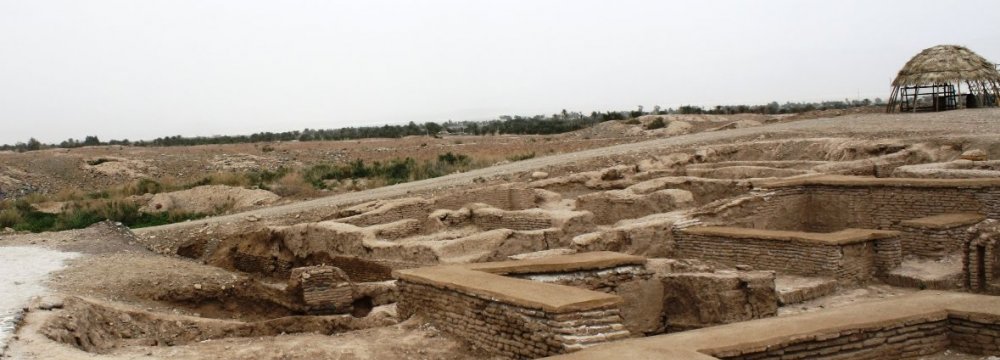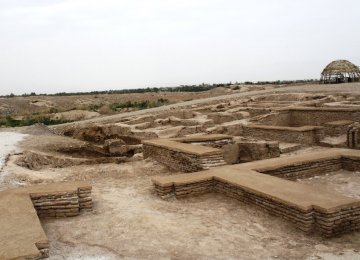Jiroft, a small city in the southeastern Kerman Province, is surrounded by mountains on three sides, rising 4,000 meters high. Geological factors have led to it being overlooked for years by tourists and archeologists, who have generally been more interested in Mesopotamia some 1,000 km away. A flood in 2001, however, led to discovery of many artifacts believed by archeologists to belong to the early Bronze Age (late 3rd millennium BC), according to La Vie, ICHHTO news agency reported. The Jiroft culture is believed to be older than Sumerian culture, which raises the question whether Halil River should now be called the cradle of civilization.
Lost Civilization
The 2001 flash flood revealed one of the “lost and forgotten” civilizations of the ancient world in the plains of the Halil River. Reports say, “an old object was seen floating on the surface of the water” and was retrieved by a peasant from a nearby village. Realizing it was precious, the following day, villagers impoverished by two years of drought, swarmed the river banks in search of 5,000 year old antiquities. They carefully divided the area into sixty square meter lots, so to give each family a fair chance at striking it rich, which they did indeed! In approximately nine months, looters had dug 10,000 holes in the ground and in cemeteries to discover objects of incomparable beauty, of a civilization that once must have rivaled those of Mesopotamia and Egypt.
Cultural Racketeering
Where there are looters, there are also dealers waiting to smuggle ancient objects out of the country. Thousands of objects including Chlorite vases carved with motifs of animals and plants, human shapes and fantastic creatures, encrusted with turquoise, lapis lazuli and marble appeared in art galleries across New York, London and Paris. It is unclear how many objects were obtained from the illegal excavations and sold to smugglers.
It was only in the fall of 2002, that the government stepped in to halt the looting and seized about 1500 of stolen artifacts. Beautiful steatite vases represent an amazing world of ancient myths, realities, and dreams. Many of them were inlaid with precious and semi-precious stones emphasizing the importance and fascination with both the sacred and the profane.
In 2003, the government invited Jean Perrot, the French archeologist who as the director of French National Centre for Scientific Research (CNRS) had conducted excavations in Shush (or Susa, an ancient city of the Elamite empires in Khuzestan Province of Iran) area between 1969 and1978.
Referring to the discovery of the Jiroft artifacts as an archeological revolution, Perrot stated: “An area we formerly regarded as resided only by nomads and their cattle, was in fact the heart of an incredibly advanced civilization. In this area people lived with social hierarchy. These people had an explicit view of the world which distinguishes them from the Sumerians. Henceforth, we must consider Jiroft as the origin of civilizations and refer to all other civilizations as pre or post Jiroft civilization.”
Recovering What Remains
Finally, under the leadership of Dr. Yousef Madjidzadeh, a team of international archaeologists began excavations in 2003. Simultaneously an awareness program was initiated for the locals to lecture to them about the historical significance of Jiroft and the irreplaceable artifacts.
Majidzadeh and his team of experts uncovered more than two square kilometers of remains from a city dating back to at least the late 3rd millennium B.C. The data demonstrates that Jiroft’s heyday was from 2500 B.C. to 2200 B.C. Astonishingly the chlorite vases found in Jiroft were not an unfamiliar object for the archeologists. Chlorite vessels similar to the stunning examples unearthed at Jiroft had been found from the Euphrates to the Indus, as far north as the Amu Darya and as far south as Tarut Island, on the Persian Gulf coast of Saudi Arabia.
Even though the cemeteries were brutally destroyed by looters, the residential areas have remained almost intact. Majidzadeh’s team were able to identify over 400 sites located in the area of about 4,000 square km. Focusing on two hills of Konar Sandal, he has been able to identify a construction which he classifies as a ziqqurat (a temple-tower of Mesopotamian origin) and a citadel, both dated by him to the 3rd millennium BC. Studies and tests have continued in subsequent years with an active international collaboration. Majidzadeh says archeological survey of the area could take as long as 30 years and believes that Jiroft is the lost link of the chain of civilization.
Law suit
In 2006 the Iranian government demanded the London-based Barakat Galleries Ltd. (“Barakat”) the restitution of a collection of eighteen carved jars, bowls and cups. Iran alleged that these objects had been recently unlawfully excavated in the Jiroft region of Iran. Barakat refused. The following year, the Iranian government sued Barakat. The governement (claimant) asserted that the antiquities had been taken in violation of its national ownership law given that, under Iranian law, the only owner of all antiquities – including those excavated in the Jiroft area is the Iranian State. In March 2007, the High Court of London, dismissed the claim on the grounds that Iran had not provided sufficient proof of ownership under Iranian laws and hence it had no title.
The government appealed the decision by arguing that the judge failed to recognize that Iran had ownership title to the antiquities and hence the right to recover them. Finally, in December 2007, the Court of Appeal reversed the decision of the High Court and maintained that the relevant laws of Iran were sufficiently clear to vest ownership and an immediate right of possession of the relics to the Iranian State. Furthermore, it affirmed that the Iranian claim to recover the antiquities, which formed part of its cultural heritage, should not be shut out on the ground that domestic courts should not entertain legal actions brought by foreign sovereigns to enforce its penal, revenue, or other public laws. In 2008 the House of Lords rejected Barakat’s application to appeal the Court of Appeals decision.
“Archaeologists’ Lost Paradise”
Five excavation seasons have been carried out at the Jiroft site, under the supervision of Prof. Majidzadeh, leading to the discovery of a ziggurat made of more than four million mud bricks dating back to circa 2200 BCE.
After numerous rare discoveries in the region, Majidzadeh declared Jiroft to be a cradle of art and civilisation, and named it as the “archaeologists’ lost paradise”.





